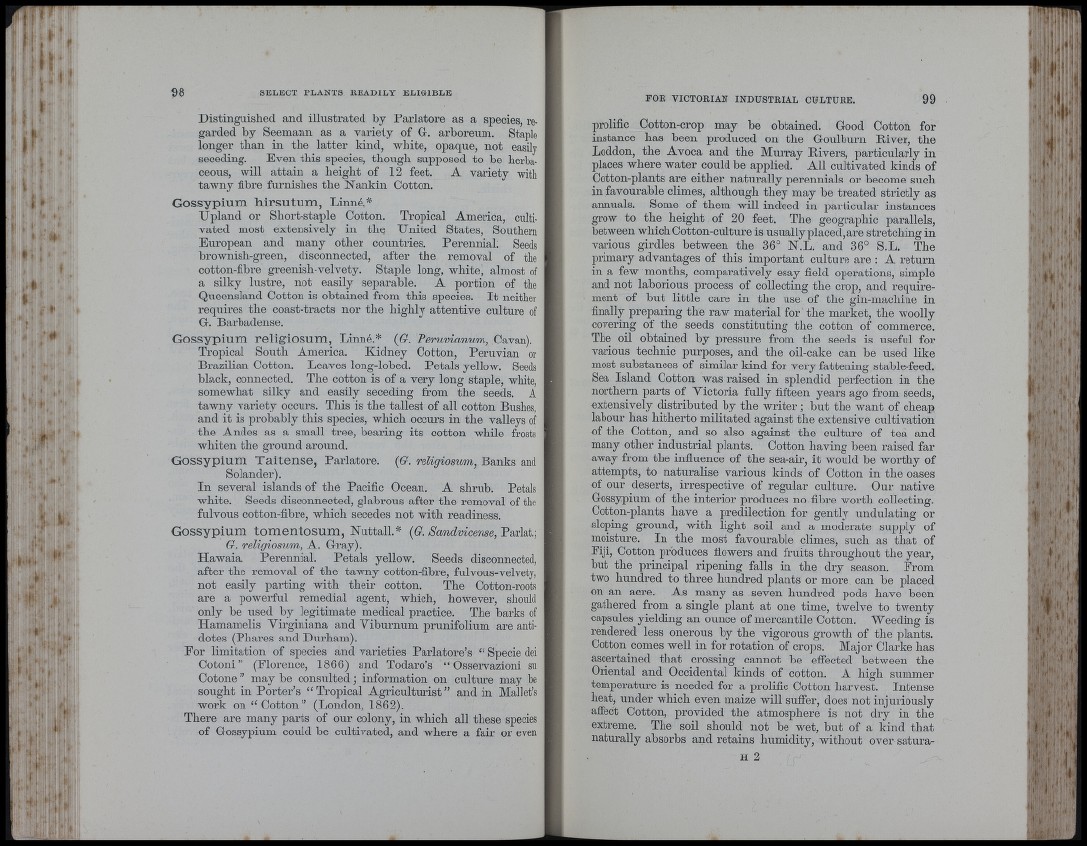
tfi ,• ‘
, I
'
II,
98 SELECT PLANTS READILY ELIGIBLE
Distinguished and illustrated by Parlatore as a species, regarded
by Seemann as a variety of G. arboreum. Staple
longer than in the latter kind, white, opaque, not easily
seceding. Even this species, though supposed to be herbaceous,
will attain a height of 12 feet. A variety witli
tawny fibre furnishes tbe Nankin Cotton.
Gossypium hirsutum, Linné.*
IJpland or Short-staple Cotton. Tropical America, cultivated
most extensively in the United States, Southern
European and many other countries. Perennial. Seeds
brownish-green, disconnected, after the removal of the
cotton-fibre greenish-velvety. Staple long, white, almost of
a silky lustre, not easily separable. A portion of the
Queensland Cotton is obtained from this species. I t neithev
requires tbe coast-tracts nor the highly attentive culture of
G. Barbadense.
Gossypium religiosum, Linné.* {G. Peruvianum, Cavan),
Tropical South America. Kidney Cotton, Peruvian or
Brazilian Cotton. Leaves long-lobed. Petals yellow. Seeds
black, connected. The cotton is of a very long staple, white,
somewhat silky and easily seceding from the seeds. A
tawny variety occurs. This is the tallest of all cotton Bushes,
and it is probably tbis species, which occurs in the valleys of
the Andes as a small tree, bearing its cotton while frosts
whiten the ground around.
Gossypium Taitense, Parlatore. {G. religiosum, Banks and
Solander).
In several islands of the Pacific Ocean. A shrub. Petals
white. Seeds disconnected, glabrous after the removal of the
fulvous cotton-fibre, which secedes not with readiness.
Gossypium tomentosum, Nuttall.* {G. Sandvicense,TaY\a\.\
G. religiosum, A. Gray).
Hawaia. Perennial. Petals yellow. Seeds disconnected,
after the removal of tbe tawny cotton-fibre, fulvous-velvety,
not easily parting with tbeir cotton. The Cotton-roots
are a powerful remedial agent, which, however, should
only he used by legitimate medical practice. The barks of
Hamamelis Yirginiana and Yiburnum prunifolium are antidotes
(Phares and Durham).
Eor limitation of species and varieties Parlatore’s “ Specie dei
Cotoni” (Florence, 1866) and Todaro’s “ Osservazioni su
Cotone ” may be consulted ; information on culture may be
sought in Porter’s “ Tropical Agriculturist” and in Mallet’s
work on “ Cotton” (London, 1862).
There are many parts of our colony, in which all these species
of Gossypium could be cultivated, and where a fair or even
FOR VICTORIAN INDUSTRIAL CULTURE. 99
prolific Cotton-crop may be obtained. Good Cotton for
instance has been produced on the Goulburn Biver, the
Loddon, the Avoca and the Murray Bivers, particularly in
places where water could be applied. All cultivated kinds of
Cotton-plants are either naturally perennials or become such
in favourable climes, although they may be treated strictly as
annuals. Some of them will indeed in particular instances
grow to the height of 20 feet. The geographic parallels,
between which Cotton-culture is usually placed, are stretching in
various girdles between tbe 36° N.L. and 36° S.L. The
primary advantages of tbis important culture are : A return
in a few months, comparatively esay field operations, simple
and not laborious process of collecting the crop, and requirement
of but little care in the use of the gin-machine in
finally preparing the raw material for the market, the woolly
covering of the seeds constituting the cotton of commerce.
The oil obtained by pressure from the seeds is useful for
various technic purposes, and the oil-cake can be used like
most substances of similar kind for very fattening stable-feed.
Sea Island Cotton was raised in splendid perfection in tbe
northern parts of Yictoria fully fifteen years ago from seeds,
extensively distributed by the w rite r; but the want of cheap
labour has hitherto militated against the extensive cultivation
of the Cotton, and so also against the culture of tea and
many other industrial plants. Cotton having been raised far
away from tbe infiuence of tbe sea-air, it would be worthy of
attempts, to naturalise various kinds of Cotton in the oases
of our deserts, irrespective of regular culture. Our native
Gossypium of the interior produces no fibre worth collecting.
Cotton-plants have a predilection for gently undulating or
sloping ground, with light soil and a moderate supply of
moisture. In the most favourable climes, such as that of
Fiji, Cotton produces fiowers and fruits throughout the year,
but the principal ripening falls in the dry season. From
two hundred to three hundred plants or more can be placed
on an acre. As many as seven hundred pods have been
gathered from a single plant at one time, twelve to twenty
capsules yielding an ounce of mercantile Cotton. Weeding is
rendered less onerous by tbe vigorous growth of the plants.
Cotton comes well in for rotation of crojis. Major Clarke has
ascertained th a t crossing cannot be effected between the
Oriental and Occidental kinds of cotton. A high summer
temperature is needed for a prolific Cotton harvest. Intense
heat, under which even maize will sufier, does not injuriously
afiect Cotton, provided the atmosphere is not dry in the
extreme. The soil should not be wet, but of a kind that
naturally absorbs and retains humidity, without over satura-
H 2
, ''rnui
L :■ 4
I ' |<:l
' ï - r ,
: I
Î'
I *
I !
Iv
i ■ t
\ ■
t"
I■ü ! •'
éi
'
Il
'•M 1 '
I
'/}' , I
i ' ,
f .